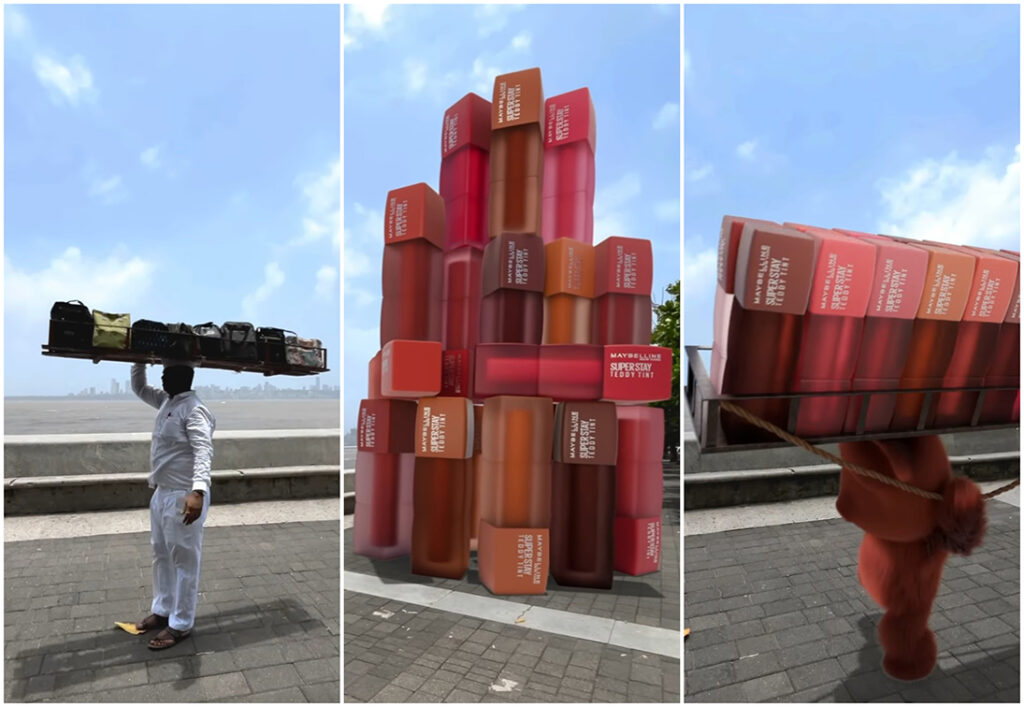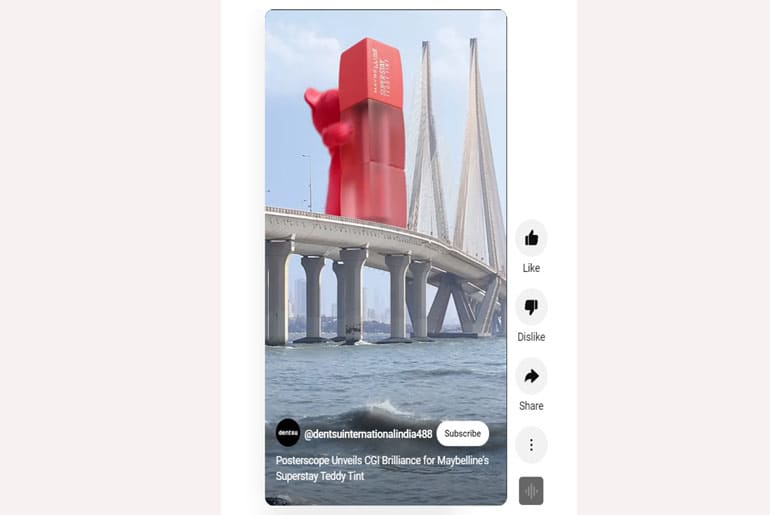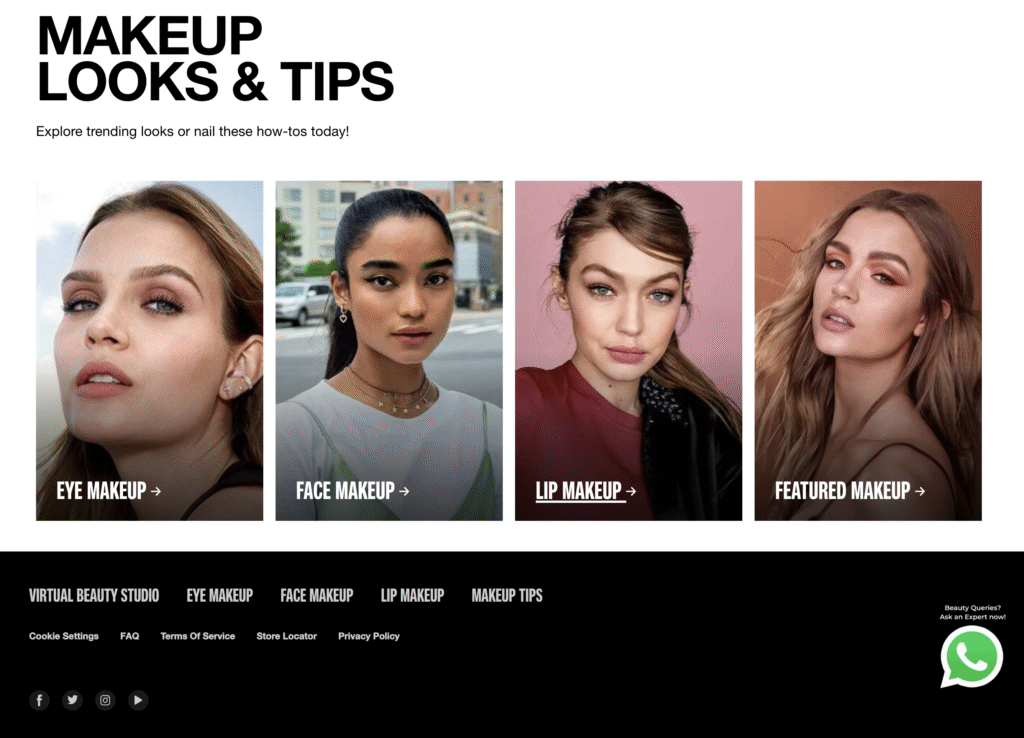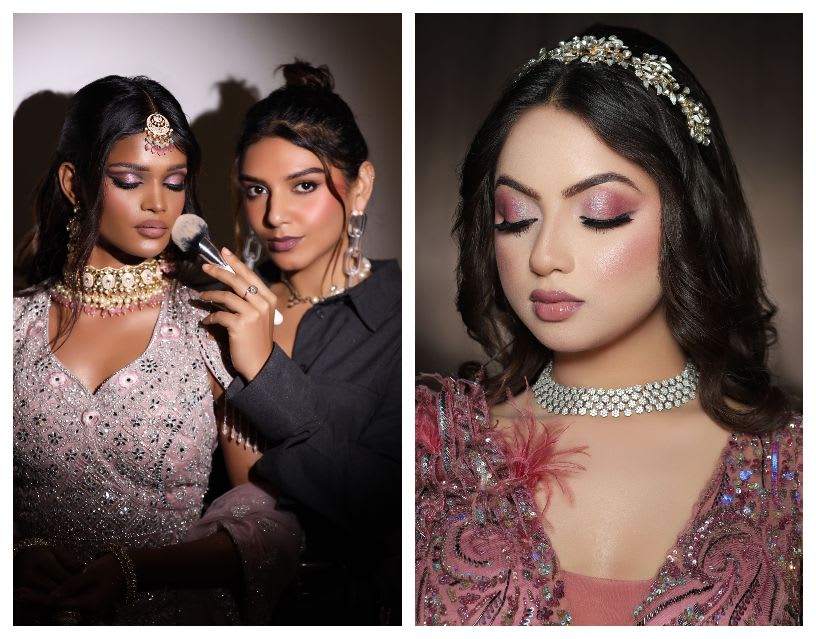
In the sultry humidity of a Mumbai monsoon, where tiffin carriers clink against bicycle frames and the city’s famed dabbawalas navigate flooded streets with clockwork precision, something curious appeared on the horizon this past July. A colossal CGI teddy bear, rendered in the algorithmic perfection of digital artists, materialised above the Worli Sea Link—clutching a tube of Maybelline’s Super Stay Teddy Tint like a cosmetic colossus surveying its domain.

Mumbai monsoon flooding impacting local railway tracks and daily commuter life realitytoursandtravel
The spectacle was undeniably impressive. Posterscope India had conjured a hyperreal marketing moment that transformed Mumbai’s skyline into a beauty billboard, complete with the kind of viral-ready imagery that sends metrics soaring and executives reaching for champagne. Yet in the shadow of this pixel-perfect bear, a more troubling story emerged—one that reveals the growing chasm between global beauty brands’ digital ambitions and their cultural comprehension.
The Dabbawalas and the Digital Divide
The irony was as thick as Mumbai’s monsoon air. Maybelline’s campaign ostensibly celebrated the city’s legendary dabbawalas, those white-capped logistics wizards who have been delivering homemade lunches across the metropolis for more than a century. Their system, built on human relationships and hyperlocal knowledge, represents everything the CGI spectacle was not: authentic, rooted, and irreplaceably human.

A Mumbai dabbawala with a bicycle carrying multiple tiffin boxes, exemplifying traditional lunch delivery service independent.co
Consider the profound disconnect: a brand invoking a service predicated on trust and personal connection through the most impersonal medium imaginable—computer-generated imagery floating above one of India’s busiest bridges. The dabbawalas’ legendary reliability stems from their intimate knowledge of Mumbai’s rhythms, their ability to read the city’s pulse through years of lived experience. Maybelline’s teddy bear, by contrast, existed nowhere except in the digital ether, a marketing mirage that vanished the moment the campaign ended.

CGI teddy bear holding Maybelline’s Superstay Teddy Tint on Mumbai’s Worli Sea Link as part of a high-profile digital campaign mediainfoline
The campaign’s creative director might argue that this juxtaposition was intentional, a clever commentary on tradition meeting modernity.
But the more likely explanation is simpler and more damning: the campaign appropriated the signifiers of local culture while remaining fundamentally indifferent to its substance.
The dabbawalas became merely another exotic backdrop against which to project Western beauty ideals, their cultural significance flattened into a convenient metaphor for product reliability.
The Aesthetics of Alienation

A curated showcase from Maybelline India’s “Makeup Looks & Tips” page, emphasizing the digital-first presentation of trending beauty categories.
This cultural flattening extends beyond the campaign’s outdoor elements to Maybelline India’s digital presence, where the brand’s relationship with its intended audience grows even more tenuous. Just scrolling of the company’s homepage reveals a landscape notably devoid of Indian faces, regional festivals, or local beauty traditions. Instead, visitors encounter the same globalised aesthetic that might appear on Maybelline’s websites in Montreal or Manchester: sleek product shots, AI-powered virtual try-on tools, and marketing copy that could have been translated by an algorithm.

Indian woman with natural skin tone and minimalistic styling representing authentic beauty womenshealthmag
The implications stretch beyond mere representation.
By constructing a digital storefront that feels imported rather than embedded, Maybelline signals something more troubling about how global beauty conglomerates view emerging markets.
These are not communities to be understood or celebrated, but territories to be conquered through the deployment of familiar formulas. The virtual try-on technology, while impressive, becomes a substitute for genuine cultural engagement—a way of seeing without truly looking.
This is particularly striking in India, where beauty traditions span millennia and encompass an extraordinary diversity of regional practices, skin tones, and aesthetic ideals. The country that gave the world kajal, turmeric face masks, and elaborate mehendi designs finds itself represented by a brand that seems to have learned about Indian culture through a weekend Wikipedia binge.

Women showcasing traditional Indian beauty with authentic attire and jewelry, emphasizing diverse cultural aesthetics thevoiceoffashion
The Economics of Authenticity
The disconnect between Maybelline’s spectacle and Mumbai’s reality reflects a broader crisis in contemporary marketing: the belief that cultural resonance can be purchased rather than earned.
The CGI teddy bear cost thousands of dollars and weeks of production; sitting down with actual dabbawalas to understand their work and perspectives would have cost significantly less but required something more valuable—genuine curiosity about the communities the brand claims to serve.
This economic logic pervades the beauty industry’s approach to cultural diversity. Brands would rather invest in expensive technological solutions—virtual try-on apps, AI-powered shade-matching tools, hyperreal outdoor advertising—than in the slower, less quantifiable work of building authentic relationships with local communities. The result is a kind of aesthetic apartheid, where brands speak at rather than with their intended audiences.
The consequences extend beyond hurt feelings or missed marketing opportunities. When beauty brands consistently fail to see and represent the communities they serve, they perpetuate the very cultural hierarchies they claim to challenge. The message, however unintended, is clear: your stories matter only insofar as they can be remixed into our narrative.
Beyond the Bear
The most insidious aspect of Maybelline’s Mumbai moment may be how perfectly it encapsulates the contradictions of contemporary consumer capitalism. The brand’s marketing materials brim with language about “celebrating diversity” and “honoring local culture,” while the actual campaign substitutes a digital teddy bear for genuine human connection. It’s a perfect metaphor for an economy that has learned to commodify authenticity while remaining fundamentally inauthentic.

A Mumbai dabbawala walks next to Maybelline’s CGI teddy bear mascot near the sea, highlighting the campaign’s blend of local culture and digital imagery mediainfoline
This is not simply a story about one beauty brand’s cultural misstep, but about the broader crisis of representation in our hyperconnected yet increasingly alienated world. When global corporations can conjure spectacular digital experiences without ever meaningfully engaging with the communities they claim to celebrate, we have perhaps reached a new stage in the evolution of cultural appropriation—one where even the appropriation has been automated.
The dabbawalas will continue their routes long after Maybelline’s CGI bear has faded from social media feeds and marketing case studies. Their lunch deliveries will persist not because of their scalability or their alignment with global beauty trends, but because they meet a fundamental human need with skill, care, and an understanding born of decades of service. In a world increasingly dominated by digital mirages, such authenticity becomes not just valuable but subversive.
Perhaps that’s the real lesson of Maybelline’s Mumbai spectacle: in our rush to capture attention, we risk losing sight of what actually deserves it.
The city’s true beauty lies not in CGI bears hovering over sea links, but in the everyday grace of its dabbawalas, the resilience of its monsoon commuters, and the rich complexity of its cultural traditions—none of which require special effects to be extraordinary.
Sources:
- https://www.linkedin.com/pulse/new-yorker-magazine-fixations-its-outlier-house-style-grobler-la8df
- https://www.newyorker.com/culture/cultural-comment/cultural-criticism-and-the-way-we-live-now
- https://www.buzzincontent.com/story/india-single-s-changing-beauty-culture-and-the-role-of-brands/
- https://melhealy.wordpress.com/2016/06/15/new-yorker-style/
- https://www.newyorker.com/books/page-turner/stuart-hall-and-the-rise-of-cultural-studies
- https://www.istitutomarangoni.com/en/maze35/industry/indias-beauty-revolution
- https://www.nytimes.com/2025/03/12/style/new-yorker-style-guide.html
- https://www.newyorker.com/magazine/2023/01/23/has-academia-ruined-literary-criticism-professing-criticism-john-guillory
- https://homegrown.co.in/homegrown-explore/kulfi-beauty-is-rooted-in-cultural-representation-diversity-creative-self-expression
- https://wallraff.substack.com/p/the-new-new-yorker-style
- https://www.newyorker.com/culture/cultural-comment/the-critic-who-convinced-me-that-criticism-could-be-art
- https://www.thinkwithgoogle.com/intl/en-apac/consumer-insights/consumer-trends/fashion-beauty-influencer-marketing-india/
- https://en.wikipedia.org/wiki/The_New_Yorker
- https://www.newyorker.com/books/page-turner/a-critics-manifesto
- https://connect.in-cosmetics.com/ingredients-formulation/understanding-the-diverse-landscape-of-indian-consumers/
- https://www.newyorker.com/tag/writing
- https://www.nytimes.com/section/opinion/culture
- https://www.theestablished.com/self/beauty/how-beauty-campaigns-in-india-became-inclusive-diverse-and-authentic
- https://www.jquiambao.com/write-like-a-new-yorker
- https://www.newyorker.com/culture
- https://www.harpersbazaar.in/beauty/story/borrowed-beauty-1031567-2024-06-23
- https://kloudportal.com/how-to-ensure-cultural-sensitivity-in-your-digital-marketing/
- https://ijcrt.org/papers/IJCRT2402747.pdf
- https://economictimes.com/industry/cons-products/fashion-/-cosmetics-/-jewellery/prada-vs-kolhapuri-chappals-controversies-around-cultural-appropriation-highlight-need-for-increased-gi-tagging-in-india/articleshow/122409060.cms
- https://www.ogilvy.com/ap/ideas/social-apacs-great-disconnect-how-social-can-better-connect-across-culture-brand-business
- https://kb.gcsu.edu/researchday/2024/all/167/
- https://www.linkedin.com/pulse/legal-implications-cultural-appropriation-indian-fashion-goswami-20dlc
- https://www.emerging-strategy.com/culture-in-the-digital-landscape-how-platform-services-are-navigating-the-cultural-journey/
- https://www.purplegoatagency.com/insights/inclusivity-beauty-industry/
- https://timesofindia.indiatimes.com/life-style/fashion/buzz/american-designer-in-trouble-over-cultural-appropriation-what-about-the-brands-that-take-inspiration-from-india/articleshow/70095214.cms
- https://www.bcg.com/publications/2017/sales-leadership-disconnect-divide-digital-marketing-talent
- https://www.mckinsey.com/industries/consumer-packaged-goods/our-insights/black-representation-in-the-beauty-industry
- https://www.localsamosa.com/people-culture/cultural-appropriation-costs-indian-artisans-heavily-9509190
- https://www.nojitter.com/employee-experience/addressing-cultural-disconnection-with-collaboration-insights
- https://trilogylaboratories.com/problems-in-the-beauty-industry/
- https://maverickbird.com/india/west/rajasthan-india-3/understanding-cultural-appropriation-on-a-jaipur-handicrafts-tour/
- https://www.linkedin.com/pulse/disconnect-culture-specific-campaign-may-make-your-brand-shirley-chio
- https://www.bsr.org/en/primers/human-rights-priorities-for-beauty-and-personal-care-sector
- https://www.theestablished.com/style/fashion/when-does-inspiration-become-cultural-appropriation-in-the-fashion-industry
- https://www.tandfonline.com/doi/full/10.1080/23311975.2025.2486590
- https://projects.iq.harvard.edu/files/hks-communications-program/files/new_seglin_how_to_write_an_oped_1_25_17_7.pdf
- https://files.eric.ed.gov/fulltext/ED404672.pdf
- https://orchidlifesciences.com/cosmetic-manufacturers-in-mumbai/
- https://agentmajeur.fr/en/why-and-how-to-write-an-opinion-piece/
- https://www.slideshare.net/susiswo/cultural-criticism
- https://www.cosmenova.in/top-20-cosmetic-manufacturers-in-mumbai/
- https://help.nytimes.com/115003870867-Reader-Submissions/115014809107-New-York-Times-Opinion-Guest-Essays
- https://www.poetryfoundation.org/education/glossary/cultural-criticism-cultural-studies
- https://www.cosmoprofindia.com
- https://communicators.duke.edu/writing-media/writing-effective-op-eds/
- https://en.wikipedia.org/wiki/Cultural_critic
- https://professionalbeauty.in/professional-beauty-india-2
- https://en.wikipedia.org/wiki/Op-ed
- https://leemartinauthor.com/2012/11/26/creative-cultural-criticism-a-writing-exercise/
- https://www.cosmoprof.com/en/corporate/cosmoprof-network/cosmoprof-made-exhibitions/cosmoprof-india-mumbai/
- https://www.newyorker.com/tag/opinions
- https://www.vox.com/culture/2018/12/31/18152275/criticism-explained-cultural-writing
- https://in.indeed.com/q-beauty-industry-l-mumbai,-maharashtra-jobs.html
- https://www.youtube.com/watch?v=xHsTgonU0yY
- https://drc.usask.ca/projects/frankenstein/cultint.htm
